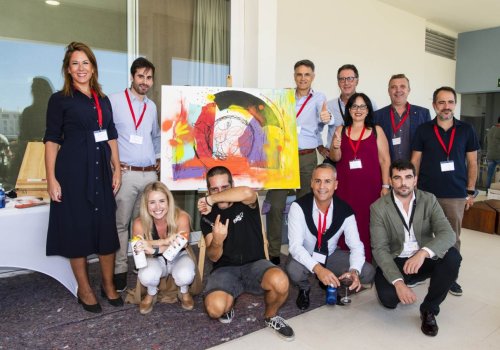
The use of art and artists in corporate events and team-building activities is definitely a growing trend. Some examples on how art and events combine to create amazing experiences :
- Art-Based Team Building Workshops:
- Collaborative Art Projects: Encouraging teams to work together on a single art piece fosters teamwork, communication, and creativity.
- Painting or Sculpting Workshops: These allow employees to express themselves creatively, which can help relieve stress and improve morale.
- Live Art Demonstrations:
- Live Painting Performances: Artists create art in real-time during an event. This can serve as entertainment and inspiration for attendees.
- Interactive Art Stations: Stations set up with supplies for attendees to create their own art pieces.
- Art Installations: Temporary or Permanent Art Installations: These can be set up in the workplace to inspire creativity and serve as conversation starters.
- Art-Based Competitions: Art Contests: Encouraging employees to submit their own artwork based on a theme can be a fun and engaging way to involve everyone.
- Cultural and Diversity Inclusion: Showcasing Local Artists: This supports the local arts community and exposes employees to different cultural perspectives.
- Art as Branding: Customized Artwork: Art can be commissioned to reflect the company's values, mission, or products.
- Themed Events: Art-Related Themes: Organizing events around specific art movements, styles, or historical periods.
- Art Therapy and Mindfulness: Art for Well-being: Using art as a form of relaxation and stress relief can be integrated into wellness programs.
- Digital and Virtual Art Experiences: Online Workshops and Exhibitions: This allows remote teams to participate in art-related activities.
- CSR Initiatives with Art:Art Auctions or Sales for Charity: Partnering with local artists or art organizations to support charitable causes.
- Customized Souvenirs:Personalized Artwork or Prints: Providing attendees with a memento from the event.
- Augmented Reality (AR) and Virtual Reality (VR): Immersive Art Experiences: Using technology to create interactive and virtual art installations.
Remember, the effectiveness of these activities largely depends on the preferences and interests of the employees. It's important to gauge the feedback and adjust future activities accordingly. Additionally, ensure that any use of art is culturally sensitive and inclusive. Always consider the diversity of your team when implementing art-related activities.
